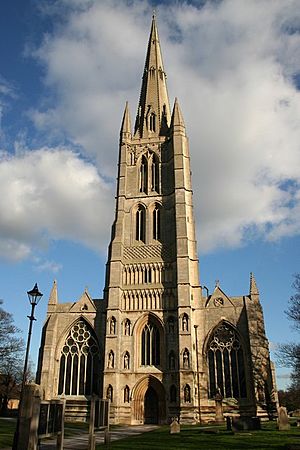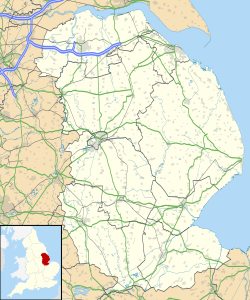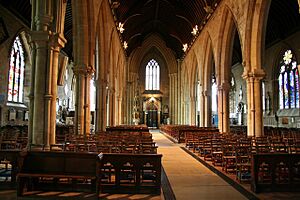St Wulfram's Church, Grantham facts for kids
Quick facts for kids St Wulfram's Church, Grantham |
|
|---|---|

Parish Church of St Wulfram, Grantham
|
|
| 52°54′53″N 0°38′27″W / 52.9148°N 0.6407°W | |
| Location | Grantham, Lincolnshire |
| Country | England |
| Denomination | Church of England |
| Churchmanship | Broad Church/Inclusive catholic |
| Website | stwulframs.org.uk discoverstwulframs.org.uk |
| History | |
| Dedication | Wulfram of Sens |
| Architecture | |
| Heritage designation | Grade I listed |
| Specifications | |
| Capacity | Seating for 700, room for a further 200 standing |
| Length | 196 feet (60 m) |
| Width | 75 feet (23 m) |
| Spire height | 274 feet (84 m) |
| Bells | 14 (1676:1946:2000:2012) |
| Tenor bell weight | 32cwt 1qtr 11lbs in C# |
| Administration | |
| Parish | Grantham |
| Deanery | Grantham |
| Archdeaconry | Boston |
| Diocese | Lincoln |
| Province | Canterbury |
St Wulfram's Church, Grantham, is a very old and important church in Grantham, Lincolnshire, England. It's a parish church, which means it serves the local community. This church is special because it's a Grade I listed building, meaning it's protected for its historical value. It also has the second tallest spire in Lincolnshire, after St James' Church, Louth.
Contents
Past Leaders of the Church
The Reverend William Glaister was a leader at St Wulfram's Church in 1876. His sister, Elizabeth Glaister, was a writer who also loved embroidery. She made beautiful embroidered pieces for the church.
The Amazing Spire
Many people think St Wulfram's has one of the best church spires in England. The famous writer Simon Jenkins called it "the finest steeple in England." In 2020, an online contest even named it the best non-cathedral church in England!
The spire is very tall, reaching 274 feet (84 m) into the sky. It's one of the tallest church spires in the whole country. It's the third highest of any parish church, after the Church of St Walburge, Preston, and St James' Church, Louth. It is the second highest Anglican parish church in the UK.
In 2013, people started a special effort to raise money to help keep the spire safe and strong.
Music at St Wulfram's
St Wulfram's Church has a rich history of music.
Church Bells and Clock
In 1877, some old church chimes that hadn't been used for years were fixed. A new clock and chimes, made by Gillett and Bland, started working on February 16, 1877. A famous expert, Sir Edmund Beckett, checked the new clock later that year. He said it was one of the best clocks Gillett and Bland had ever made!
The Grand Organ
The church has a very old and impressive organ. It was first built in 1735 by John Harris and John Byfield. Over the years, it has been rebuilt and improved many times. In 1906, Norman and Beard rebuilt it, creating the organ you can hear today. It was updated again in 1952, 1972, and 1993–94. During the last update, a fourth keyboard was added.
The beautiful wooden case around the organ was designed by Sir Walter Tapper RA and took eight years to finish. The old organ case now holds the choir's changing room in the church. Many people believe this organ is one of the best in Lincolnshire.
Organists of St Wulfram's
- Mr Sweet 1745–1755
- Andrew Strother 1755–1816 (with Francis Sharp 1808–1816)
- Francis Sharp 1808–1832 (with Andrew Strother 1808–1816)
- William Dixon 1832–1865
- George Dixon 1865–1886
- Richard Thomas Back 1886–1911
- Frank Radcliffe 1911–1914
- Edward Brown 1914–1941
- Stephen John Mundy 1941–1961
- Philip Joseph Lank 1961–1983
- Nicholas Kerrison 1984–1988
- John Ball 1988–1992
- John Wilkes 1992–1996
- Ian Major 1996–1997
- Philip Robinson 1997–2001
- Michael Sands 2002–2007
- Tim Williams 2008–
Gallery
-
The church painted by J. M. W. Turner, around 1797
See also
- Bishop of Grantham







